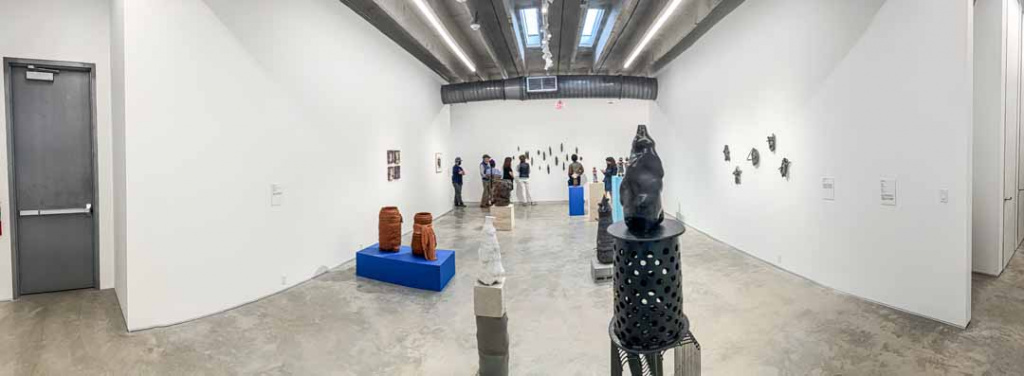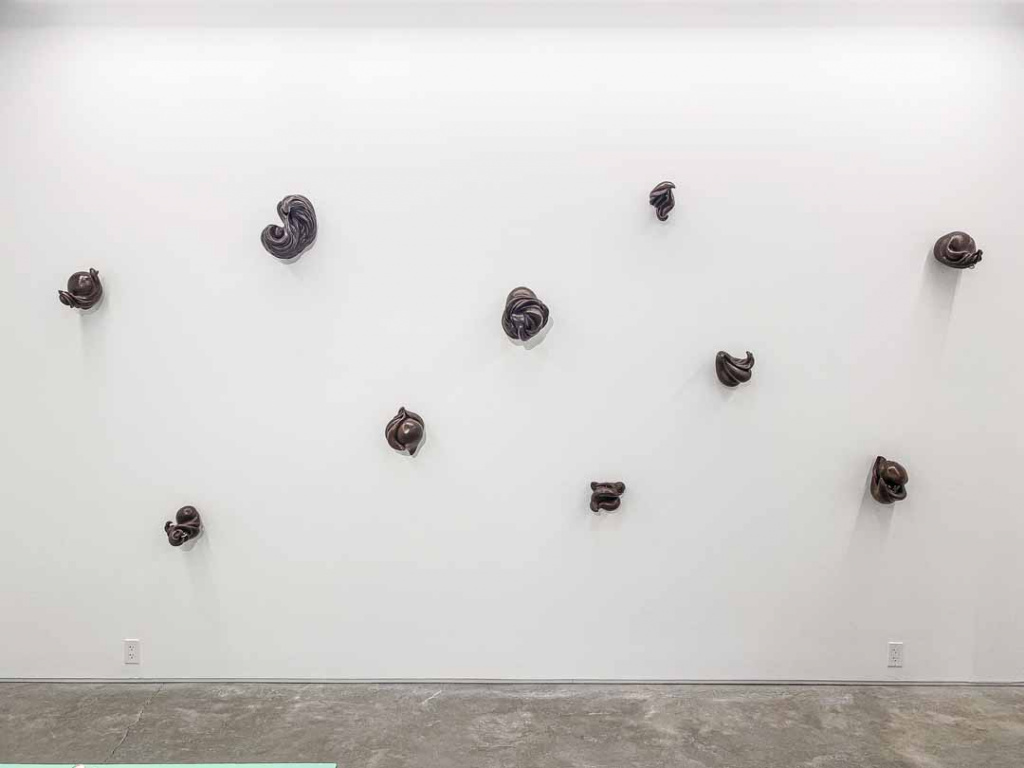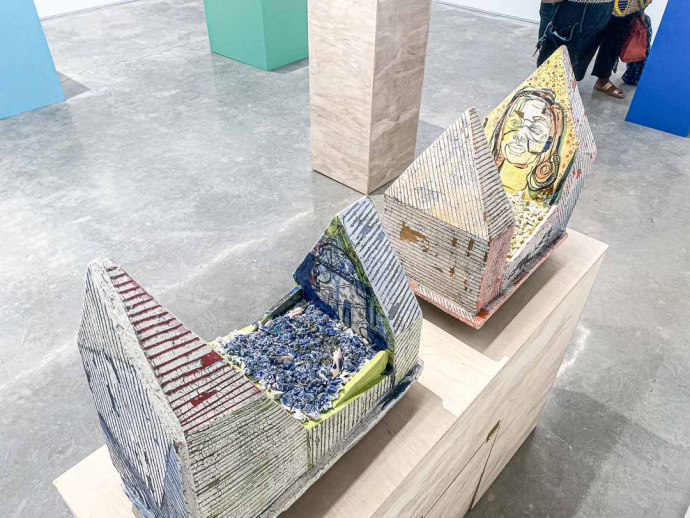“The Universe Within” @ Mindy Solomon Gallery

Anina Major, Lola Ayisha Ogbara, Lydia C Thompson, Malene Barnett, Maya Beverly, Maya Vivas, Patrice Renee Washington, Sana Musasama, Sharon Norwood, Shea Burke, Sydnie Jimenez
Curated by Angelik Vizcarrondo-Laboy

The Universe Within
The Universe Within is not a definitive statement on who women-identifying and non-binary people of the Black diaspora are. Instead, it is a space that recognizes their limitless potential to be. Layered, dynamic, complex, nuanced, ever-evolving. A multitude of selves within the vessel of their bodies. Like our universe, mysterious and mystical, their interiority is rich and vast. This exhibition is a privileged glimpse into the wondrous multiformity within the spectrum of Black femininity and queerness.
Extending over three rooms, eleven artists take up space, an understated form of resistance. Recurrent themes surveyed in the exhibition include the relationship between self and place, nurturing individual and collective identity, transformation, celebration, survival, ancestral lineages, navigating the problematic expectations and violence imposed on their bodies, and the importance of reclaiming childhood.

The artists of The Universe Within use clay as their primary vehicle for storytelling. An ancient and elemental medium, long marginalized in the art world. Parallelly, the field of studio ceramics has notoriously underrepresented Black artists for decades, especially those who are women-identifying and non-binary. However, the sculptures and vessels, both abstract and figurative, created by the artists of The Universe Within demonstrate that clay—which is capable of impressive transfiguration—is an effective tool for empowering their narratives in their quest for liberation, connection, and beauty.

Maya Beverly’s “The Sapphire Child” series presents different variations of a figurative vessel assembled using the same molded elements. While each is different, they share a common origin point. This series embodies identity plurality as well as ancestral lineages. Depicting a face framed by a “door knocker” earring and long twisted tresses, Beverly’s Door Knocker investigates adornments, specifically hair and jewelry, as extensions of the body that speak to interconnectivity and ideas of a boundless body. Inspired Black science fiction writers Octavia E. Butler and N.K. Jemisin, Patrice Renee Washington explores the connection between a sense of self and physical landscape. Envisioning the artifacts she would leave behind, Washington makes monolithic sculptures, such as Onyx Peak decorated with protective hairstyles like Bantu knots and braids, that continue her examination of Black hair and its relationship to vulnerability, protection, and survival. Speaking to issues of race, gender, beauty, and class Sharon Norwood uses the line, a formal element of drawing, as her primary tool. In her work, lines curve to become curls, celebrating Black hair. Norwood’s “Entanglement” sculptures, porcelain curls decorated with flowers and gold luster, underscore the preciousness and beauty of not only Black hair but Black bodies.
Anina Major’s installation features porcelain “straw dolls”—a take on a traditional craft and souvenir from her native Bahamas—watching over four plaited vessels, personifying the elements of water, fire, earth, and wind. Her archetypical ceramic weaving technique developed through her mission to redefine the value of the labor, materials, and people associated with straw doll production. Dolls and vessels together demonstrate Major’s artistic evolution while discussing the marketplace as a political space and ways of cultivating a sense of belonging. Lydia C. Thompson’s “The Relic” series is an array of house-shaped sculptures that resemble working-class family homes in dilapidated and vacant states. She smashes her grandmother’s reclaimed ceramic figurines, most of which are indicative of a Eurocentric aristocratic lifestyle, into the rubble that fills the “houses.” The crushed ceramics convey bad memories, loss of family, unemployment, shattered dreams, and purging society of confederate monuments. Malene Barnett’s What’s Left Behind/Dreaming of America commemorates the hardship, beauty, and joy of her family’s migration from the Caribbean. The abstract rendered portraits of silhouettes and bold patterns, a call-back to Barnett’s background in textile design, focus on generations of women in her family that have influenced who she is.
Maya Vivas’ “in their own image” series of sinuous sculptures imagines a transformative diasporic body memory for a futuristic Black Queer community. Octavia E. Butler’s research into slime mold colonies which shaped the extraterrestrial beings who repopulate a post-apocalyptic Earth in her “Lilith’s Brood” trilogy, influenced Vivas’ divination of survival through their resilient biomorphic seed pods adaptable to the environment. In a new body of work, Lola Ayisha Ogbara references bell hooks’ homeplace: a site of resistance in an inquiry of interiority and spatiality. Ogbara uplifts Black feminine identities through ambiguous bodily sculptures on stacked stools—borrowing from Mid-Century Modern design and West African ceremonial seating objects—that allow for rest and conservation. Using the ceramic language of their ancestral homeland Shea Burke creates vessels that honor the physical and emotional labor of those who came before them. In a new series, they use the vessels as proxy bodies to address their chest dysphoria as a non-binary person, poetically stressing the burdening implications of the body.
Sana Musasama’s work denounces systems that deny Black women the possibility of fully realizing their lives and bodies. She has worked on her “Unspeakable” series for decades, responding to the loss of innocence and wonderment that she witnessed as Mende thirteen-year-old girls from Sierra Leone returned after a marriage ritual of genital mutilation changed forever. Her “Girl Soldiers” series also speaks of enforced rights of passages that violently curtail childhood by throwing girls into the turmoil of civil wars. Her work pleads to allow Black girls to simply be girls. Sydnie Jimenez’s figurative sculptures celebrate Brown and Black youth and emphasize the importance of taking up space and protecting this community. Each with a distinct personal style, the sculptures are love letters to the family and friends who uplift her.

